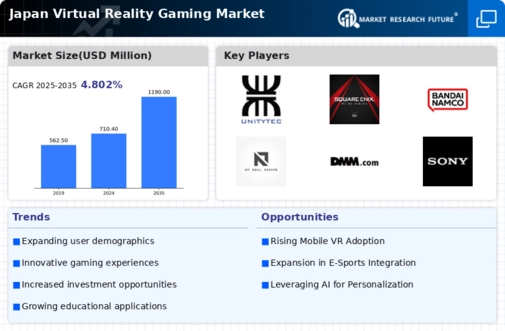Expansion of VR Gaming Communities
The expansion of VR gaming communities is significantly impacting the virtual reality gaming market in Japan. As more players engage with VR technology, online communities and social platforms dedicated to VR gaming are flourishing. These communities provide a space for players to share experiences, strategies, and content, fostering a sense of belonging. In 2025, it is estimated that the number of active VR gaming community members in Japan will reach over 2 million, indicating a growing interest in collaborative gaming experiences. This social aspect of VR gaming not only enhances player engagement but also encourages the development of multiplayer games, which are likely to become a staple in the virtual reality-gaming market. The interconnectedness of these communities may also drive word-of-mouth marketing, further propelling market growth.
Cultural Integration in Gaming Content
Cultural integration plays a pivotal role in the virtual reality gaming market in Japan. Developers are increasingly incorporating local themes, folklore, and historical narratives into VR games, which resonates with the Japanese audience. This approach not only enhances the gaming experience but also fosters a sense of cultural pride among players. As of 2025, it is estimated that culturally themed VR games could account for up to 30% of the total VR gaming market in Japan. This trend suggests that the virtual reality-gaming market is not merely a platform for entertainment but also a medium for cultural expression. By blending traditional elements with cutting-edge technology, developers are likely to attract a diverse range of players, thereby expanding the market's reach.
Increased Investment in VR Development
Investment in VR development is a crucial driver for the virtual reality gaming market in Japan. With the growing recognition of VR's potential, both established gaming companies and startups are channeling resources into creating innovative VR experiences. In 2025, it is projected that investment in VR gaming development in Japan will surpass $500 million, reflecting a strong commitment to advancing the technology. This influx of capital is likely to lead to the development of more sophisticated games and applications, enhancing the overall quality of VR offerings. Furthermore, partnerships between technology firms and gaming studios are becoming more common, fostering collaboration that could yield groundbreaking advancements in the virtual reality-gaming market.
Rise of Esports and Competitive Gaming
The virtual reality-gaming market in Japan is significantly influenced by the rise of esports and competitive gaming. As esports continues to gain popularity, VR gaming is increasingly being integrated into competitive formats. This trend is evident in the growing number of VR esports tournaments, which attract both players and spectators. In 2025, the revenue generated from VR esports in Japan is estimated to exceed $300 million, indicating a robust interest in competitive VR gaming. The immersive nature of VR enhances the spectator experience, making it more engaging compared to traditional gaming formats. This shift towards competitive VR gaming not only boosts participation but also encourages investment in VR technologies, further propelling the growth of the virtual reality gaming market in Japan.
Technological Advancements in VR Hardware
the virtual reality gaming market in Japan is experiencing a surge due to rapid technological advancements in VR hardware. Innovations such as improved headsets, motion tracking, and haptic feedback systems are enhancing user experiences. For instance, the introduction of lightweight headsets with higher resolution displays has made VR gaming more accessible and enjoyable. As of 2025, the market for VR headsets in Japan is projected to reach approximately $1.5 billion, reflecting a growth rate of around 20% annually. This technological evolution not only attracts gamers but also encourages developers to create more immersive content, thereby driving the overall growth of the virtual reality-gaming market. Furthermore, the integration of artificial intelligence in gaming experiences is likely to enhance interactivity, making VR gaming more appealing to a broader audience.






















Leave a Comment